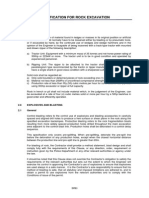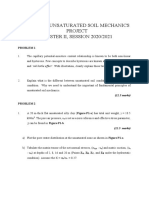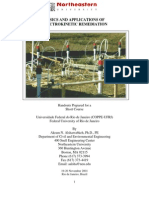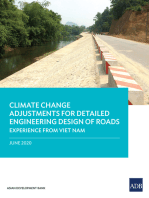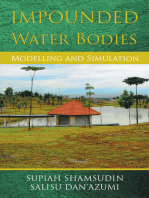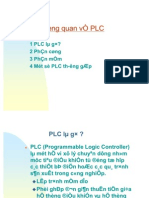Recent Studies On Piled-Raft Foundation: State of Art: V.J.Sharma, S.A.Vasanvala, C.H.Solanki
Recent Studies On Piled-Raft Foundation: State of Art: V.J.Sharma, S.A.Vasanvala, C.H.Solanki
Uploaded by
Mặc Thế NhânCopyright:
Available Formats
Recent Studies On Piled-Raft Foundation: State of Art: V.J.Sharma, S.A.Vasanvala, C.H.Solanki
Recent Studies On Piled-Raft Foundation: State of Art: V.J.Sharma, S.A.Vasanvala, C.H.Solanki
Uploaded by
Mặc Thế NhânOriginal Title
Copyright
Available Formats
Share this document
Did you find this document useful?
Is this content inappropriate?
Copyright:
Available Formats
Recent Studies On Piled-Raft Foundation: State of Art: V.J.Sharma, S.A.Vasanvala, C.H.Solanki
Recent Studies On Piled-Raft Foundation: State of Art: V.J.Sharma, S.A.Vasanvala, C.H.Solanki
Uploaded by
Mặc Thế NhânCopyright:
Available Formats
JOURNAL OF INFORMATION, KNOWLEDGE AND RESEARCH IN
CIVIL ENGINEERING
RECENT STUDIES ON PILED-RAFT FOUNDATION:
STATE OF ART
1
V.J.SHARMA, 2 S.A.VASANVALA, 3C.H.SOLANKI
1, 2, 3
Applied Mechanics Department, Sardar Vallabhai National Institute of Technology,
Ichchhanath, Surat-7, Gujarat,India.
nitk.vijay@gmail.com
ABSTRACT : Due to increase of civilization in recent decades the demand of land for construction purpose has
increased exponentially. As most of the time site available consists of weak subsoil conditions, piled raft
foundation has been preferred on large scale due its efficiency of carrying high vertical loads within the
permissible settlement limits and cost effectiveness compared to pile foundation system. This paper presents the
brief review of various studies on piled-raft foundation in last decade. The paper also reveals latest
modification done in conventional piled-raft as per site conditions and loading criteria.
Keywords: Differential Settlement, Total Settlement, Finite Element Method, Non-Identical Piles, Composite
Piled-Raft, Viscohypoplastic
1. INTRODUCTION review of various studies carried out on piled-raft
In traditional foundation design, it was customary to foundation in clayey soil, sandy soil and weathered
consider first the use of shallow foundation such as a rocks. Various researchers have worked on piledraft
raft (possibly after some ground-improvement foundation system in clayey soil. Their work includes
methodology performed). If it was not adequate, deep study related to bearing behavior, composite system,
foundation such as a fully piled foundation was used non-linear FEM analysis, piled-raft system with non-
instead. In the former, it was assumed that load of identical piles, etc. The Studies related to sandy soil
superstructure was transmitted to the underlying includes separate analysis of pile and raft, case
ground directly by the raft. In the latter, the entire studies and use of FEM codes. Few works has been
design loads were assumed to be carried by the piles carried out on weathered rock which includes paper
[24].In recent decades, another alternative [3,7,10,and 25].Researcher [7] has carried out work
intermediate between shallow and deep foundation, in sand as well as weathered rock.
what is called piled raft foundation or settlement 2 .REVIEW
reducing piles foundation, has been recognized by The review includes various papers published in
civil engineers. The piled raft concept has been used various journals such as American society of civil
extensively in Europe and Asia. In this concept, piles engineering, Proceedings of the 17th International
are provided to control settlement rather than carry Conference on Soil Mechanics and Geotechnical
the entire load. Piled raft foundation has been proved Engineering ,Proceedings of ICE , etc .They have
to be an economical way to improve the been grouped into major areas as:
serviceability of foundation performance by reducing 1. Study of pile raft system in clay
settlement to acceptable levels. The favorable 2. Study of pile raft system in sand and
application of piled raft occurs when the raft has weathered rock
adequate loading capacities, but the settlement or 2.1 Study of pile raft system in clay :
differential settlement exceed allowable values. In situations where a raft foundation alone does not
Conversely, the unfavorable situations for piled raft satisfy the design requirements, it may be possible to
include soil profiles containing soft clays near the enhance the performance of the raft by the addition of
surface, soft compressible layers at relatively shallow piles. The use of a limited number of piles,
depths and some others [24]. In the unfavorable strategically located, may improve both the ultimate
cases, the raft might not be able to provide significant load capacity and the settlement and differential
loading capacity, or long-term settlement of the settlement performance of the raft. The study on
compressible underlying layers might reduce the design of piled-raft system in clayey soils have been
contribution of raft to the long-term stiffness of carried by [25, 15, 32, 31, 27, 28 19, 22 and 12].The
foundation. As we know piled-raft foundation system design of piled raft system involves basically bearing
is applied in weak subsoil conditions where chances capacity of supporting subsoil and permissible
of foundation settlement play vital and major role in allowable total and differential settlements. Poulos
design of foundation system. This paper presents H.G. [25] had given outline of simplified method of
ISSN: 0975 6744| NOV 10 TO OCT 11 | Volume 1, Issue 2 Page 38
JOURNAL OF INFORMATION, KNOWLEDGE AND RESEARCH IN
CIVIL ENGINEERING
carrying out a preliminary feasibility study and Element Method (FEM): (1) the problem is so
design of a piled raft system. The analysis is complex that simplified methods cannot model the
programmed via a spreadsheet program or a problem correctly; and (2) codes for the FEM are
mathematical program such a MATHCAD. The available, powerful, and capable of being run on the
approach gives a reasonable estimate of the order of personal computer. Comparisons were made between
the magnitude of settlement and differential experimental and analytical results for two piled raft
settlement of foundation when applied to case study foundations resting on stiff clay and the FEM has
of piled raft on stiff clay and series of centrifuge tests shown to yield excellent results for the cases
on reconstituted soil. Liew S. S etal [15] have analyzed .Oh E.Y.N etal. [22] have carried out
designed and presented instrumentation results of numerical analysis of un-piled raft and piled raft on
reinforcement concrete piled raft supporting 2500Ton two different soil conditions. The analysis was
oil storage tanks on a very soft alluvial clayey soil of carried out in two case studies with three typical load
about 40m thick in Riau Province of Sumatra, intensities of serviceability load. The subsoil was
Indonesia. The design concept has been validated modeled as linear elastic materials, raft as beam
with the results of instrumentation Seo Y.K etal [32] element and piles as element with shear and normal
have proposed design charts of piled raft foundations coupling springs. For case study 1 with sandy soil
on soft clay. The design charts were first presented condition maximum settlement of piled raft depends
for the evaluation of both bearing capacity and total on piles spacing and number of piles. For case study
settlement in the raft alone foundation system. Load 2 with clayey subsoil, the settlement of un-piled raft
settlement relationship curves are used to evaluate the was similar for different raft thickness .Raft thickness
ultimate soil bearing capacity. The total settlement is was found to have obvious effect on differential
evaluated by applying various traditional safety settlement. The settlement of piled raft at piled area
factors of the uniformly distributed loads. Then, the showed a bowl shape settlement pattern and edge of
parametric studies were carried out for the piled raft the raft strip showed a downward deviation from
foundation system. In the numerical analyses, elasto- the settlement bowl. Lee J H.etal [12] has conducted
plastic finite elements models are used to present the series of 3D elasto-plastic finite element analyses to
foundation response and the design charts, which investigate the bearing behavior of a square piled raft
enable the determination of the raft size and pile subjected to vertical loading. In this study, the main
length and spacing of piles. Sanctis L.D etal. [31] has characteristic of these analyses was to permit soil slip
proposed a simple design criterion to evaluate the at the pilesoil interface. Pile positions, pile number,
ultimate vertical load of a piled raft as a function of pile length and loading distributions on the raft were
its component capacities, which can be simply varied, and the effects of pilesoil slip, pile
evaluated by the conventional bearing capacity geometries and loading types were examined.
theories. A broad parametric study is carried out Furthermore, the proportion of load sharing of the
using 3D FEM analysis to define the failure load raft and piles at the ultimate state and the relationship
coefficients accounting for the interaction between between the settlement and overall factor of safety
the raft and the pile group at failure. Also a guideline was evaluated. The results show that the use of a
has been given to assess the factor of safety of limited number of piles, strategically located, might
vertically loaded piled raft. As per Meisam Rabiebi improve both bearing capacity and the settlement
[27] the maximum bending moment in raft increases performance of the raft. The work related to piled-
with increase raft thickness, decrease pile number raft foundation resting on over-consolidated clay was
and decrease in pile length. Central and differential carried out by [8, 29, 30], which includes numerical
settlement decreases with increase raft thickness and study of piled-raft foundation behavior and
uniform increase in pile length. Further Meisam comparison with field measured results. Reul O.etal
Rabiei [28] used a computer program ELPLA and [30] carried out comparisons of in-situ
found that pile configuration and load distribution measurements and numerical analyses for three
are very important and effective in piled raft piled raft foundations on over-consolidated clay
settlement , maximum moment and pile bearing between overall settlement , differential settlement
factor. Three basic pile configurations and three load and load carried by piles by back analysis. Three
distribution types were considered. Pile configuration main performance indicators of the piled raft were
1 has the pile uniformly distributed under whole raft proposed: the proportion of load carried by the
area. Pile configuration 2 has piles under central piles,and the maximum settlement and maximum
area of the raft as well as under the edge of the raft. differential settlement, both as a proportion of the
In pile configuration 3 the piles are placed only in the corresponding quantity for an unpiled raft
central area of the raft, the detail is shown in fig.1 . foundation. The last indicator suggests that improved
Novak L.J etal [19] carried out analysis of pile-raft layout of the pile support can lead to a reduction both
foundations with 3D finite-element method .They in the maximum differential settlement and in the
found following reasons for use of the 3D Finite overall quantity of piles.
.
ISSN: 0975 6744| NOV 10 TO OCT 11 | Volume 1, Issue 2 Page 39
JOURNAL OF INFORMATION, KNOWLEDGE AND RESEARCH IN
CIVIL ENGINEERING
Figure 1. Model configuration and properties used in the analysis
Garcia F etal [8] had applied viscohypo plastic beneath the raft was used to redistribute and adjust
model to the case history of piled raft the stress ratio of piles to subsoil. Researchers [13,
foundation- Messeturm tower in Frankfurt 41, 14, 40] had carried out rigorous analysis on
Germany with 3D FEM analysis with ABAQUS CPRF system .Liang F.Y. etal [13] have carried out
and the user subroutine UMAT developed by A. numerical analysis of composite piled raft with
Niemunis and the geotechnical group of the cushion subjected to vertical load. Influencing
Karlsruhe university in Germany. The calculated factors such as ratio of length to diameter and
results are compared with the in situ measurements elastic moduli of piles as well as thickness and
with the purpose to verify the viscohypoplastic law elastic modulus of cushion were studied in details.
in a boundary value problem. It was found that Load-sharing ratios of piles and subsoil as well as
viscohypoplastic model can predict with good level foundation settlement were also investigated.
of agreement the behavior of a piled raft Zheng J.J. etal [41] carried out 3D non-linear finite
foundation. Reul O. [29] has carried out numerical element modeling of composite foundation formed
study of bearing behavior of piled rafts in by Cement-Flyash-Gravel-lime piles which is a
overconsolidated clay. It is shown that the widely used ground improvement technique. A
interaction between piles and rafts is a major CFGlime multi-pile composite foundation is a
influence on bearing capacity of piled-raft new concept utilizing CFG and lime piles as shown
foundation. in fig 2. The parameters studied include the length
To mobilize shallow soil in coastal areas to and diameter of piles and the thickness of the
participate in the interaction of piled raft foundation cushion. The stress distribution beneath the
sufficiently, the researchers extended the concept of composite foundation, the influence of the cushion
piled raft to a new type of foundation named on load-settlement behavior, and the ratio of
composite piled raft. In the system of composite stresses in the piles to those in the subsoil are also
piled raft, the short piles made of flexible materials studied. The results show that settlement is much
were used to strengthen the shallow soft soil, while more significantly affected by the length and
the long piles made of relatively rigid materials diameter of the CFG pile rather than that of the
were used to reduce the settlements and the cushion lime pile, thus CFG pile acts as a settlement-
ISSN: 0975 6744| NOV 10 TO OCT 11 | Volume 1, Issue 2 Page 40
JOURNAL OF INFORMATION, KNOWLEDGE AND RESEARCH IN
CIVIL ENGINEERING
reducing pile. On the other hand, the load
distribution between piles and subsoil is
significantly affected by the cushion thickness.
Optimization of composite piled raft foundation
with varied rigidity of cushion was carried out by
Liang F.etal [14 ].The analysis model of piled raft
foundation was set up using the fictitious pile
method , and Fredholms integral equations of the
second kind were deduced to solve the
problems .By simulating the cushion with wrinkle
springs , the effect of cushion was taken into
consideration. The method is suitable to analyze the
foundation under working loads and could be
applied to solve problems of different rigidities of Figure 3. Finite element discretization for piled-
piles and cushion. ZHAO M.H.etal [40 ] have raft
carried out settlement calculation for long short
composite piled raft foundation.Based on the shear A windows based general-purpose finite element
deformation method,the Mylonakis and gazetas program (AMPS) was used to carry out the
model was introduced . Considering the effects analyses.A suitable nonlinear model is used to
of cushion , the flexible factors of interaction model the soil behavior ,and contact interfaces are
were provided.Then the settlement calculation included to study the interaction between soil and
for long-short composite piled raft foundation piles and between soil and slab .Two piled-raft
was developed. The non-linear analyses of piled- system were analyzed. It was found that the
raft foundation have been interesting area of study contribution of the pile tip in the resistance tends to
for many researchers which include [16, 17, 37, 33, increase as the deformation increases.Non-linear
and 4].Maharaj D.K etal [16] worked on non-linear finite element analysis of piled-raft foundation
finite element analysis of piled raft foundation resting on layers of soil having different stiffness
resting on clay soil layers .. In this study the raft have been done by [33,4,5]. Small J.C.etal [33] has
and piles are assumed to be linearly elastic and developed a method of analysis for piled raft
Drucker-Prager criterion has been used to represent foundation where piles exhibits nonlinear load
soil as elasto-plastic material.Based on three- deflection behavior. The raft is analysed by finite
dimensional non-linear finite element analysis, it element methods, while the piles are treated as
was found that the addition of even a small number springs having a variable stiffness,so as to model
of piles increases the load-carrying capacity of a any non-linear behaviour. The soil is treated as an
raft foundation. The axial load distribution shows elastic medium that may consist of layers of soil
that the piles reach their ultimate capacity earlier having different stiffnesses. The method has been
than the raft. Maharaj D.K. [17 ] continued his incorporated into the computer program GARP
work in non-linear finite element analysis of piled (General Analysis of Rafts with Piles). This
raft foundation under the application of uniformly program is used to analyse a tall building that was
distributed load .Fig 3 shown below gives finite constructed on a piled raft foundation, and a
element discretization and boundary conditions comparison is made of the calculated and observed
applied to pile raft foundation. Load settlement behaviour. Chen J etal [4] has presented a nonlinear
curves of raft and piled raft foundation have been analysis method for simulating the interaction of
provided for different raft and pile stiffness. superstructure pile-raft-soil system in layered
Vsquez L.G etal [37] had carried out non-linear soil.The flexibility coefficients of the pile-pile and
three-dimensional finite element analysis to the pile-soil are deduced , the stiffness matrix of
estimate capacity of piled raft. the pile-soil system is established, and interaction
equation of superstructure pile-raft soil system is
formulated. The distribution of the settlement of
the foundation ,which was large in the middle and
small in the boundary and like a dish, was
consistent with the measured data in field.
Further using nonlinear analysis method and
program of the interaction of superstructure-pile-
raft-soil system in layered soil ,reaction force on
pile head and displacement characteristic of raft
Figure 2. Sketch of CFG lime pile composite of the piled raft foundation were analysed when
foundation the thickness of the raft, spacing of piles ,length and
diameter of piles were changed. Recently it has
been found that piled-rafts having non-identical
ISSN: 0975 6744| NOV 10 TO OCT 11 | Volume 1, Issue 2 Page 41
JOURNAL OF INFORMATION, KNOWLEDGE AND RESEARCH IN
CIVIL ENGINEERING
piles shows efficient performance, researchers piled-raft foundation system founded in sand
[36,5,35,6] had worked in the field of piled-raft separately and find out the behavior of piled-raft
with non-identical pile lengths.Tan Y.C etal [36] has foundation as whole. Cao X.D etal [2 ] have carried
given a design approach in which foundation of out study on behavior of model rafts resting on
medium rise building is designed using skin- disconnected piles which act as reinforcement in
friction piles of different length with longer piles at base soil (sand in this case ) rather than structural
the center and progressive shorter pile towards the element . By varying factors such as raft stiffness,
edge.For detailed design of foundation two cases pile length, pile arrangement, and pile number,
were considered.Case 1 considers overall results of the investigation indicate that structurally
settlement behavior of foundation system to predict disconnected piles are effective in reducing the
settlement profile for structural design .Meanwhile settlement and bending moment in model rafts.
case 2 considers interaction between the pile-soil- Nemoto H.etal[18] have carried out series of
structure (foundation raft) of foundation system to experimental and analytical study on the
determine load distribution and local settlement of behaviors of model pile groups and model piled
piles and also structuraldesign of raft to rafts in dry sand subjected to static vertical load
complement case 1. The foundation system was and static cyclic horizontal load to establish an
monitored and the results obtained showed that adequate analytical method and seismic design
foundation system adopted performed satisfactory. method . An emphasis was placed on the
Chow H.S.W etal [ 5] have used finite layer method influence of the connection condition between
for the analysis of piled rafts with piles of different the pile head and raft on the behaviors of the
lengths and diameters. The soil is divided into model foundations .The test apparatus including
horizontal layers with different material properties model foundations , model ground , loading ,
and only vertical loads may be applied to the raft. measuring devices and test procedure were
Interactions between raft-soil-pile are computed described in detail. Sonoda R.etal [34] has applied
Comparisons of actual measurements and the simple conservative design approach for design of
results of finite element calculations have shown foundation. As per design approach building and its
that the finite layer method can provide reasonably foundation were constructed in sandy ground using
accurate solutions. It is very easy to prepare data a reverse construction method. The main difference
for the finite layer analysis as only the pile between a reverse construction method and a
locations and properties need to be specified, and conventional construction method is that the piles
the piles discretised into linear elements. This are cast in place and are partially loaded by the
method is more efficient than the conventional superstructure early during the construction
three-dimensional finite element analysis. Tan Y.C process. It is only later that the raft (mat
etal [35] discussed methodology of a floating foundation) is constructed to combine with the piles
piled raft foundation system consisting of non- to bear the full building load. To examine the
identical piles with longer piles in central portion validity of the design method, settlements of the
and progressively shorter piles towards edge for foundation were observed during construction. The
medium rise building (5-storey) on soft clay.Two measured settlements were smaller than those
major cases were considered for detail foundation predicted in the design stage, satisfying the design
analysis and design. Case 1 of pile-soil-structure requirements for the building design.
interaction was taken in consideration to determine In recent years analysis of piled-raft foundation in
stress distribution, deformation and settlement of sandy subsoils using finite element code has
raft and piles. Case 2 considers overall settlement increased exponentially. The researchers [23,22, 20,
behavior of piled raft (immediate and consolidation 21, 1, 11, 42 and 9] had carried out extensive
settlement). Chow H.S.W [6] has done her Phd research in the same. They have used various finite
thesis on behavior of piled rafts supported by element codes to incorporate the exact field
non-identical piles examined by use of computer conditions.Paranmoyes etal [ 23] have illustrated
program APRILS based on finite layer and finite the process of design of a piled raft foundation for a
element methods.The finite layer method is used large residential development using a three stage
for analysis of layered soil system. This method can procedure, consisting of an initial assessment of the
be applied different shape of loadings and has feasibility of the design, a middle stage of refining
shown good agreement with the theoretical pile locations and depths, and a detailed design
solutions.The FEM is used for analysis of raft and stage of assessing the behaviour of the foundation
piles. Full interaction between raft, piles and soil is under various loading cases using GARP8
considered in the analysis. computer program. The utilization of a piled raft
2.2 Study of pile raft system on sand and foundation versus a conventional piled only
weathered rock:This section of the paper deals foundation delivered the required serviceability
with piled raft foundation system in sandy soil and performance with regard to total and differential
weathered rock conditions. The researchers [2, 18, settlements while providing cost savings estimated
and 34] have studied effect of piles and raft in a to be of the order of 30% versus the original pile-
ISSN: 0975 6744| NOV 10 TO OCT 11 | Volume 1, Issue 2 Page 42
JOURNAL OF INFORMATION, KNOWLEDGE AND RESEARCH IN
CIVIL ENGINEERING
only solution Oh E .Y. N.etal[20] have carried out fitted on a dense sand layer , but there are clay
parametric study on piled raft foundation in sand layers of medium consistency along the shaft
using numerical modeling with three typical load and below the support soil.Owing to this , the
intensities of serviceability load. The maximum piles are subjected to negative skin friction , the
settlement of the piled rafts depends on the pile raft has suffered important settlements , the
spacing and the number of piles; while the raft structure has been damaged and the upper
thickness does not have a significant effect. The conveyor belt has experienced problems.A 3-D
increase in raft thickness reduces the differential finite element (FE) calculation has permitted
settlement in the foundations. The raft-soil calculation of the displacements and stresses in the
stiffness (Krs) is shown to influence the piles, raft and structure. A 3-D finite element (FE)
differential settlement and has the largest influence. calculation has permitted calculation of the
Oh E .Y. N.etal[21] have studied analysis of un- displacement and stresses in piles, raft and
piled and piled raft foundations with sandy soil structure.
conditions similar to those found in Surfers
Paradise of Australia. For the unpiled raft, the
normalized settlement parameter (IR) for the raft
sizes of 8m8m and 15m15m ranged as 1.02-1.15,
and 0.64-0.81 respectively. In the case of the piled
raft with raft thicknesses of 0.25, 0.4,0.8, 1.5 and
3m, the corresponding maximum settlements are
64, 63.3, 62.6, 62.3 and 62.2 mm, and the bending
moment values are 107, 160, 321, 446 and 485
kNm. The piles are 0.7m diameter and 16m length.
Three values of intensity of loading as 215, 430 and
645kN/m2 were studied. Figure 4 illustrates the
symmetric idealization of the piled raft problem.
Baziar M.H etal [1] have investigated bearing Figure 5: Numerical model of pile-raft Foundation
-settlement behavior of combined pile-raft under 1g physical test using FLAC-3D a) Total
foundations on medium dense sand Numerical mesh b) pile raft mesh
simulation was also carried out on the model test,
using FLAC-3D, to show compatibility of the Ziaie-Moayed R.etal[42] have evaluated piled raft
numerical analysis with the test.Fig 5. Shows foundations behavior with different dimensions of
numerical model mesh for piled raft and its piles.element program. They found that piled raft
surround soil in simulation of 1g physical test. foundation with different pile diameters may be a
good solution to reduce total and differential
settlements if the bottom layer is dense soil but if
bottom layer is soft soil then in that case piled raft
system with different pile lengths can control
differential and total settlements. Giretti.D [ 9] has
done Phd work in Modelling of Piled raft
foundations in sand. The main aim of thesis was to
highlight the effects of the raftsoilpile
interactions on the resistance sand. Researchers
[38,39 and 7] have carried out work on case studies
comparing the values of design settlement with the
measured values after execution of the
projects.Yamashita K etal [38] have studied a case
history of design and performance of piled raft
` supporting a 162 m high residential tower.Field
Figure 4: Finite element dealization of pile raft measurements were performed on settlement and
system load sharing of a piled raft supporting a 162m
high isolated residential tower from beginning of
Obtained results showed very good accuracy of the construction to eight month after the end of
numerical method used in this study as long as the construction.At eight months after the end of
applied load does not exceed the working load, construction, the measured settlement was 24mm
while the performance of numerical model was and the ratios of the load carried by the piles to
relatively good for the loads beyond working load. the effective load were estimated to be 0.88-0.94,
Justo J.L etal [11 ] have studied structure of a which were consistent with the design values of
copper concentrate store founded on reinforced the foundation settlement and load sharing
concrete raft supported by 697 piles. The piles are between raft and piles. Yamashita.K etal [39] have
ISSN: 0975 6744| NOV 10 TO OCT 11 | Volume 1, Issue 2 Page 43
JOURNAL OF INFORMATION, KNOWLEDGE AND RESEARCH IN
CIVIL ENGINEERING
studied a case history of seven-storey building of pile response and impact of cyclic degradation
piled raft on loose sand underlain by soft silt were assessed. Numerical analyses was used to
layers .In order to reduce consolidation settlement evaluate the overall piled raft response under
of the soft silt and to cope with liquefiable loose various static and wind loading combination as well
sand, a piled raft combined with gird form as some techniques were used to optimize the
ground improvement was adopted. The design of foundation design, including preliminary pile
the foundation was found appropriate by field testing.
measurements which concerned settlement ,axial 3. CONCLUSIONS
forces of the piles and earth pressures and pore Following conclusions can be drawn from the
water pressure beneath the raft from the various research studies:
beginning of construction to time about four Piled-raft foundation can be successively
years after the end of construction. El- applied in weak sub-soil conditions i.e. clayey,
Mossoallamy Y. etal [7] have done general over sandy and weathered rock .Piled raft foundation
view on recent innovative applications (case proves to be cost effective compared to other type
studies) of piled rafts in Germany on Frankfurt clay, of foundation systems
Berlin sand and Marl and weathered rock for Finite element method is most efficient
highway bridges .The piled raft foundation provides method to analyze complex nature of piled-raft
a new geotechnical concept not only for high rise foundation behavior in clay, sand and weathered
buildings but also for residential buildings and rock. The composite piled-raft, piled-raft with non-
bridges, which allow a high grade technical and identical piles, etc are the latest modification in
economical optimization of construction. Any kind conventional piled-raft system and found to be
of eccentric construction can be safely founded on efficient with respect to geological and loading
soft to stiff clay and also on loose to medium 4. REFERENCES
dense sand by appropriate location of piles [1] M.H Baziar, A Ghorbani, R Katzenbach.
,staggering the pile length and suitable pile Small-Scale Model Test and Three-Dimensional
diameter .The number and length of piles, the pile Analysis of Pile-Raft Foundation on Medium-
load share ,total bearing capacity of piled raft and Dense Sand. International Journal of Civil
its settlement are main criteria that should be Engineering. Vol. 7, No. 3, pp 170-175, 2009.
investigated during a feasibility study to check [2] X D Cao, H. Wang and M F
the validity of piled raft. Sometimes geological Chang .Behavior of Model Rafts Resting on Pile-
conditions at site consist of weathered rocks on Reinforced Sand, Journal of Geotechnical and
which piled raft foundation has to be laid. Recently Geoenvironmental Engineering Vol. 130, No. 2, pp.
high rise buildings are founded on weathered rock 129-138, 2004.
especially in Middle east countries. This has lead to [3] M .TA Chaudhary. FEM modeling of a
development of interest of group of researchers [3, large piled raft for settlement control in weak rock
7, 26, and 10] in field of piled- raft foundation on Engineering Structures 29, 29012907, 2007.
weathered rocks. Chaudhary M.TA [ 3 ] have [4] J Chen, Y Chang and Y Zou. Key
investigated application of a group of 1072 piles for engineering Materials (Volumes 400 -
controlling settlement of an important and sensitive 402):Advances in Concrete and Structures, pp. 651-
structure founded on weak rock.2D axi- 658
symmetrical and 3D finite element models were [5] H.S.W Chow and J.C Small. Behavior of
employed to model the 9.0 m thick and 76 m Piled Rafts with Piles of Different Lengths and
diameter circular raft, underlying soil/rock and a Diameters under Vertical Loading. Advances in
mix of annular and orthogonal pile layout. Deep Foundations (GSP 132), 2005.
Effectiveness of pile foundation in reducing [6] H.S.W Chow. Analysis of piled-raft
settlement was assessed by comparing the results foundation with piles of different length and
with the case of raft foundation alone. Poulos H.G diameter ,Phd Thesis, 2007.
etal [26] have outlined the processes followed in [7] Y.El-Mossoallamy, B.Lutz and T.Richter.
the design of the foundations for the Burj Dubai Innovative application of piled raft foundation to
and the independent verification of the design. The optimize the design of high-rise buildings and
maximum settlement predicted by ABAQUS for the bridge foundations,10th International Conference
tower and podium foundation compares reasonably on piling and deep foundations, Amsterdam 2006.
well with the maximum settlement estimated by the [8] F.Garcia,A.Lizcano, and O.Reul
revised PIGS analysis carried out during the Viscohypoplastic Model Applied to the Case
independent verification process. Ibrahim K.etal History of Piled Raft Foundation. Geotechnical
[10] have carried out piled raft foundation design Engineering in the information Technology Age,
analysis of Pentominium tower in Dubai,UAE in Atlanta,GA 1-6,(2006).
local carbonate soils and rock. Geotechnical [9] D. Giretti .Modelling of piled raft
investigations were outlined along with effect of foundations in sand ,Phd thesis (2009)
proposed tower on neighboring structures, single-
ISSN: 0975 6744| NOV 10 TO OCT 11 | Volume 1, Issue 2 Page 44
JOURNAL OF INFORMATION, KNOWLEDGE AND RESEARCH IN
CIVIL ENGINEERING
[10] K .Ibrahim, G Bunce and modeling for piled raft foundation in sand. Eleventh
C.Murrels.Foundation design for the Pentominium East Asia-Pacific Conference on Structural
tower in Dubai,UAE,Proceedings of ICE , Civil Engineering &Construction (EASEC-11).
Engineering 162, pp 2533, 2009. Building a Sustainable Environment November
[11] J.L Justo, A .Jaramillo, M .Vazquez, E 19-21, 2008, Taipei, Taiwan.
.Justo and M.T. Perez .The performance of piled [22] E.Y.N Oh, D.G Lin., Q.M Bui. , M.
raft foundations, Proceedings of the 17th Huang, C.Surarak andA.S. Balasubramaniam
international conference on Soil Mechanics and Numerical analysis of piled raft foundation in
Geotechnical Engineering (ICSMGE 2009): 1228- sandy and clayey soils.Proceedings of the 17 th
1231. International conference on Soil Mechanics and
[12] J Lee, Y .Kim, J .Sangseom Three- Geotechnical Engineering (ICSMGE 2009): 1159-
dimensional analysis of bearing behavior of 1162
piled raft on soft clay. Computers and [23] Paranmoyes , H.G. Poulos , J.C. Small
GeotechnicsVolume 37 Issue 1-2, pp. 103-114 , and F. Badelow . Piled raft design process for a
2010, high-rise building on the gold coast, Australia.
[13] F.Y. Liang, L.Z. Chen, X.G. Shi. TALL BUILDINGS from Engineering to
Numerical analysis of composite piled raft with Sustainability: 6th International Conference on Tall
cushion subjected to vertical load. Computers and Buildings, Mini Symposium on Sustainable Cities,
Geotechnics 30 (2003) 443453 Mini Symposium on Planning, Designand Socio-
[14] F. Liang, J Li and L. Chen .Optimization Economic Aspects of Tall Residential Living
of Composite Piled Raft Foundation with Varied Environment,Hongkong , pp241-249.China 2005.
Rigidity of Cushion. Proceedings of Sessions of [24] H. G Poulos,. Piled raft foundations:
GeoShanghai 2006 .Foundation Analysis and design and applications, Geotechnique 51(2001),
Design Innovative methods (GSP 153) 29-34. No. 2, 95- 113
[15] S.S Liew, S.S Gue and Y.C Tan Gue & [25] H.G Poulos Simplified design procedure
Partners Sdn Bhd, Kuala Lumpur, for piled raft foundation .Deep Foundation
Malaysia.Design and Instrumentation Results of A 2002:441-458.
Reinforcement Concrete Piled Raft Supporting [26] H.G Poulos and G.Bunce. Foundation
2500 Ton Oil Storage Tank On Very Soft Alluvium design for the burj dubai the worlds tallest
Deposits, Ninth International Conference on Piling building. Proceedings of the 6th International
and Deep Foundations, Nice, 3rd 5th June, 2002. conference on Case Histories in Geotechnical
[16] D.K Maharaj and S.R Gandhi .Non-linear engineering, Arlington, VA, 2008
Finite element analysis of piled- raft [27] M. Rabiebi.Parametric Study for Piled
foundations.Proceedings of the Institution of Civil Raft Foundations ,Electronic journal of
Engineers Geotechnical Engineering 157, 2004 Geotechnical Engineering Volume 14 ,Bundle A ,
Issue GE3 Pages 107113. 2009.
[17] D.K. Maharaj. Three [28] M. Rabiebi .Effect of Pile Configuration
DimensionalNonlinear Finite Element Analysis to and Load Type on Piled Raft. Proceedings of
Study the Effect of Raft and Pile Stiffness on the Sessions of Geoshanghai 2010 : Deep Foundations
Load-Settlement Behaviour of Piled Raft and Geotechnical Insitu testing Geotechnical
Foundations.Electronic Journal of Geotechnical special publication no. 205:34- 41
Engineering ,Volume 9 , Bundle A ,(2004). [29] O. Reul .Numerical Study of the Bearing
[18] H. Nemoto Yaegashi K, Takeuchi Behavior of Piled Rafts . International Journal of
Y,Nishimura N,Matsmoto T and Kitiyodom P. Geomechanics, Vol. 4, No. 2, 2004, pp. 59- 68
vertical load tests of model piled rafts withdifferent [30] O. Reul and M.F Randolf . Piled rafts in
pile head connection conditions,Proceedings of the overconsolidated clay: comparison of in situ
Sixth International Conference on Physical measurements and numerical analyses,
Modelling in : Geotechniques, Hongkong 2006 pp Geotechnique 53, No. 3, 301315, (2003).
853-859 . [31] L.D Sanctis and Alessandro, A Mandolini
[19] J Novak, L.C. Reese, and S.T.Wang. Bearing Capacity of Piles Rafts on Soft Clay soils.
Analysis of Pile-Raft Foundations with 3D Finite- Journal of Geotechnical and
Element Method. Proceedings of the 2005 GeoenvironmentalEngineering, Vol. 132, No.12,
Structures congress and 2005 Forensic Engineering 2006, pp. 1600-1610,
Symposium,New York. [32] Y.K Seo, K.S Choi and S.G Jeong
[20] E.Y.N Oh , Q.M Bui , C. Surarak, R Proceedings of the 13th International Offshore and
.Adamec and A.S. Balasurbamaniam Parametric Polar Engineering Conference: Design Charts of
Study on Piled Raft Foundation in Sand Using Piled Raft Foundations on Soft Clay: Honolulu,
Numerical Modeling ,www.griffith.edu.au Hawaii, USA, May 2530,2003
[21] E.Y. N Oh, M. Huang, C Surarak, R. [33] JC Small and HG Poulos.Non-linear
Adamec and A.S. Balsurbamaniam. Finite element Analysis of Piled Raft Foundations. Proceedings of
ISSN: 0975 6744| NOV 10 TO OCT 11 | Volume 1, Issue 2 Page 45
JOURNAL OF INFORMATION, KNOWLEDGE AND RESEARCH IN
CIVIL ENGINEERING
Sessions of Geo-Denver: Contemporary Issues In m High Residential Tower. Proceedings of Sessions
Deep Foundations (GSP 158) 2007.pp 1-9 of Geoshanghai Deep Foundations and
[34] R Sonoda, T Matsumoto, P Kitiyodom, H Geotechnical Insitu testing. Geotechnical special
Moritaka, and T Ono. Case study of a piled raft publication no. 205:26-33
foundation constructed using a reverse construction [39] K.Yamashita and T. Yamada Settlement
method and its post-analysis, Canadian and load sharing of a piled raft with ground
Geotechnical Journal. 46(2): 142159 (2009). improvement on soft ground, Proceedings of the
[35] YC Tan, SW.Cheah and M R Taha 17th International Conference on Soil Mechanics
Methodology for Design of Piled Raft for 5- and Geotechnical Engineering 2009: 1236-1239
Storey Buildings on Very Soft Clay. Proceedings of [40] M.H Zhao, L. Zhang, M.H Yang.
Sessions of GeoShanghai 2006 Foundation Settlement calculation for long-short composite
Analysis and Design Innovative Application piled raft foundation. Journal of Central South
(GSP153) 226-233 University of Technology, Volume 13 No.6 749-
[36] Y.C Tan, C.M Chow and C.M Gue Gue 754,(2006).
& Partners Sdn Bhd, Kuala Lumpur, [41] J.J Zheng, S.W Abusharar,and X.Z Wang.
Malaysia .Piled medium-rise buildings on very soft Three- dimensional nonlinear finite element
clay 2004. modeling of composite foundation formed by
[37] L.G Vsquez, S.T Wang, and W.M CFGlime piles. Computers and Geotechnics 35
Isenhower Estimation of the Capacity of Pile-Raft (2008) 637643
Foundations by Three- Dimensional Non-Linear [42] R. Ziaie-Moayed, M. Kamalzare and
finite Element Analysis Geo Congress 2006: M.Safavian .Evaluation of piled raft foundations
Geotechnical Engineering in the information behavior with different dimensions of piles. Journal
Technology Age (2006) 1-6 . of applied sciences 10(13):1320-1325,2010
[38] K.Yamashita,J.Hamada and Y.Soga.
Settlement and Load Sharing of Piled Raft of a 162
ISSN: 0975 6744| NOV 10 TO OCT 11 | Volume 1, Issue 2 Page 46
You might also like
- Layout3D/ Demo3D/ Sim3D/ Emulate3D 2022 Installation and Licensing Procedure (ULS)Document6 pagesLayout3D/ Demo3D/ Sim3D/ Emulate3D 2022 Installation and Licensing Procedure (ULS)Cong LiuNo ratings yet
- Soil Physical Measurement and Interpretation for Land EvaluationFrom EverandSoil Physical Measurement and Interpretation for Land EvaluationNo ratings yet
- Barbosa-Cruz & M.F. Randolph (ISFOG 2005)Document8 pagesBarbosa-Cruz & M.F. Randolph (ISFOG 2005)Pablo Cesar TrejoNo ratings yet
- Applied Mechanics of Solids (A.f. Bower) Chapter 9 - Modeling Failure - 9Document17 pagesApplied Mechanics of Solids (A.f. Bower) Chapter 9 - Modeling Failure - 9ibroniNo ratings yet
- 97 Syllabus B SC Computer ScienceDocument32 pages97 Syllabus B SC Computer ScienceraisluliincognitomaNo ratings yet
- Design of Piles Under Cyclic Loading: SOLCYP RecommendationsFrom EverandDesign of Piles Under Cyclic Loading: SOLCYP RecommendationsAlain PuechNo ratings yet
- Past and Future of Applied Soil Mechanics Article ReviewDocument1 pagePast and Future of Applied Soil Mechanics Article ReviewJacques OwokelNo ratings yet
- Swelling Potential of Compacted Expansive Soils: March 2013Document7 pagesSwelling Potential of Compacted Expansive Soils: March 2013aji wirdanNo ratings yet
- ES 230 Lecture 14 PDFDocument4 pagesES 230 Lecture 14 PDFJessie F. SermanNo ratings yet
- Mechanical ExcavationDocument17 pagesMechanical Excavationmohan_manoj43No ratings yet
- Soil MechanicsDocument19 pagesSoil MechanicsHarish R BommidiNo ratings yet
- 03-Part 2 - Overcoming Methods PDFDocument12 pages03-Part 2 - Overcoming Methods PDFSebastian Jorquera HenriquezNo ratings yet
- Specification For Rock ExcavationDocument12 pagesSpecification For Rock ExcavationGnabBangNo ratings yet
- Settlement Reducing Piles in Piled Basements and ShaftsDocument3 pagesSettlement Reducing Piles in Piled Basements and Shaftsvenkateswara rao pothinaNo ratings yet
- LicuefaciónDocument8 pagesLicuefaciónDaisy FloresNo ratings yet
- Ce 442 Foundation Engineering II - Tedu s1617 - SyllabusDocument8 pagesCe 442 Foundation Engineering II - Tedu s1617 - SyllabusRex MayabangNo ratings yet
- Scale Effect of Spread Foundation Loading Tests Using Various Size PlatesDocument8 pagesScale Effect of Spread Foundation Loading Tests Using Various Size PlatesThắng HồNo ratings yet
- AL-Kinani 2020 IOP Conf. Ser. Mater. Sci. Eng. 737 012083Document12 pagesAL-Kinani 2020 IOP Conf. Ser. Mater. Sci. Eng. 737 012083DiCkSunNo ratings yet
- 79-Article Text-432-1-10-20190501Document9 pages79-Article Text-432-1-10-20190501smit_ghoseNo ratings yet
- Standard Penetration TestDocument8 pagesStandard Penetration TestRodneyXerri100% (1)
- Coefficient of Consolidation and Its CorDocument6 pagesCoefficient of Consolidation and Its CorMD Anan MorshedNo ratings yet
- Seismic Lateral Earth PressureDocument32 pagesSeismic Lateral Earth PressureKay CharlesNo ratings yet
- Kansai Airport Settlement ReportDocument8 pagesKansai Airport Settlement ReportBarbara CunhaNo ratings yet
- Mkaj 1093 - Unsaturated Soil Mechanics Project SEMESTER II, SESSION 2020/2021Document3 pagesMkaj 1093 - Unsaturated Soil Mechanics Project SEMESTER II, SESSION 2020/2021Lingeswarran Numbikannu0% (1)
- Liquefied Srength Ratio From Liquefaction Flow Failure Casa HistoriesDocument19 pagesLiquefied Srength Ratio From Liquefaction Flow Failure Casa HistorieslinoficNo ratings yet
- PDFDocument12 pagesPDFRavi ChaliaNo ratings yet
- 1 s2.0 S277288382200084X MainDocument10 pages1 s2.0 S277288382200084X MainSAMER ALJURFNo ratings yet
- 1990 - Leroueil e Vaughan - The General and Congruent Effect of Tructure in Natural Soils and Weak RocksDocument22 pages1990 - Leroueil e Vaughan - The General and Congruent Effect of Tructure in Natural Soils and Weak RocksnsanieleNo ratings yet
- Alshawabkeh ShortcourseDocument95 pagesAlshawabkeh ShortcourseHabib Musa MohamadNo ratings yet
- Stark Etal 2009 Shear Strength MSW PDFDocument13 pagesStark Etal 2009 Shear Strength MSW PDFIziquiel CecchinNo ratings yet
- Soil Mechanics & Foundation Engineering Handout 2012-2013Document3 pagesSoil Mechanics & Foundation Engineering Handout 2012-2013Tushar GuptaNo ratings yet
- Example 1: Generation of A Bearing Graph For An Open End Diesel HammerDocument5 pagesExample 1: Generation of A Bearing Graph For An Open End Diesel HammerbozarromegustaNo ratings yet
- Mayne & Kulhawy 1982Document18 pagesMayne & Kulhawy 1982Leonardo NascimentoNo ratings yet
- The Use of Spreadsheets For The Seismic Design of PilesDocument26 pagesThe Use of Spreadsheets For The Seismic Design of PilesSewGuanNo ratings yet
- Soil Dynamics and Earthquake Engineering: Suresh R. Dash, Subhamoy Bhattacharya, Anthony BlakeboroughDocument8 pagesSoil Dynamics and Earthquake Engineering: Suresh R. Dash, Subhamoy Bhattacharya, Anthony Blakeboroughuchiha894354No ratings yet
- Correlation Between Drained Shear Strength and Plasticity Index of Undisturbed ClayDocument6 pagesCorrelation Between Drained Shear Strength and Plasticity Index of Undisturbed ClayWalidNo ratings yet
- 1987-Seismic Response of Earth Dams Some RecentDocument46 pages1987-Seismic Response of Earth Dams Some RecentANES1434No ratings yet
- The Large Displacement Shear Characteristics of Granular Media Against Concrete and Steel Interfaces - tcm12-2951Document8 pagesThe Large Displacement Shear Characteristics of Granular Media Against Concrete and Steel Interfaces - tcm12-2951adnan100% (1)
- Asadzadeh - Direct Shear Testing On A Rockfill MaterialDocument18 pagesAsadzadeh - Direct Shear Testing On A Rockfill MaterialDavid CastañoNo ratings yet
- CPT FieldDocument22 pagesCPT FieldAisha RianaNo ratings yet
- Geotechnical Engineering ReportDocument25 pagesGeotechnical Engineering ReportAbdullah YucesoyNo ratings yet
- Settlement Extreme ExampleDocument2 pagesSettlement Extreme Examplejoe_b_32607100% (1)
- Shaft Capacity of Pipe Pile in Sand - t02-093Document10 pagesShaft Capacity of Pipe Pile in Sand - t02-093senhuNo ratings yet
- Energy Piles and Other Thermo-Active Ground-Source Systems: Heinz BrandlDocument22 pagesEnergy Piles and Other Thermo-Active Ground-Source Systems: Heinz BrandlwongtianhuiNo ratings yet
- Quality Control TestsDocument22 pagesQuality Control Testsvarma369vinaNo ratings yet
- Dealing With Gypsum Karst Problem Hazard Environment Issues and PlanningDocument12 pagesDealing With Gypsum Karst Problem Hazard Environment Issues and PlanningTito Poerwo100% (1)
- Reactive Soils Can Be Vicious: Paper Presented byDocument6 pagesReactive Soils Can Be Vicious: Paper Presented byJohn Dakota100% (1)
- Soil Compaction: Principles of Geotechnical Engineering Eighth EditionDocument39 pagesSoil Compaction: Principles of Geotechnical Engineering Eighth EditionThony CayNo ratings yet
- Unsat2000 DenverDocument15 pagesUnsat2000 DenverSamuel Laura HuancaNo ratings yet
- Using Point Load Test To Determine Uniaxial STR of Coal Meassure RockDocument10 pagesUsing Point Load Test To Determine Uniaxial STR of Coal Meassure RockScott Downs0% (1)
- An Introduction to Thermogeology: Ground Source Heating and CoolingFrom EverandAn Introduction to Thermogeology: Ground Source Heating and CoolingNo ratings yet
- Disputed Earth: Geology and Trench Warfare on the Western Front 1914–18From EverandDisputed Earth: Geology and Trench Warfare on the Western Front 1914–18No ratings yet
- Climate Change Adjustments for Detailed Engineering Design of Roads: Experience from Viet NamFrom EverandClimate Change Adjustments for Detailed Engineering Design of Roads: Experience from Viet NamNo ratings yet
- A Catalogue of Details on Pre-Contract Schedules: Surgical Eye Centre of Excellence - KathFrom EverandA Catalogue of Details on Pre-Contract Schedules: Surgical Eye Centre of Excellence - KathNo ratings yet
- Privacy by Design Report v2Document32 pagesPrivacy by Design Report v2Pascal Van Hecke100% (1)
- Users Manual 2061259Document5 pagesUsers Manual 2061259Pablo Gustavo RendonNo ratings yet
- It Leader Guide To Low CodeDocument16 pagesIt Leader Guide To Low Codepomyles15No ratings yet
- XPW7-330.835.01.04.02Document13 pagesXPW7-330.835.01.04.02Nagi AbdoNo ratings yet
- Pratical File ContentDocument21 pagesPratical File ContentPoke BlastersNo ratings yet
- Giao Trinh Ly Thuyet PLC S7200Document56 pagesGiao Trinh Ly Thuyet PLC S7200nguyenhuucuong23No ratings yet
- Siemens Self-Study ClassesDocument5 pagesSiemens Self-Study Classeszaheeruddin_mohdNo ratings yet
- Essential of ColdfusionDocument45 pagesEssential of ColdfusionJedt3DNo ratings yet
- 13 05 2021+Calculus+L4+Integration+Vinay+Sir+Physics+11th+Elite+Live+VJEEDocument161 pages13 05 2021+Calculus+L4+Integration+Vinay+Sir+Physics+11th+Elite+Live+VJEEHello HellNo ratings yet
- sql1 PDFDocument87 pagessql1 PDFAnonymous Gd16J3n7No ratings yet
- How To Identify Authentic ASIX USB To LAN ProductsDocument13 pagesHow To Identify Authentic ASIX USB To LAN Productsoussama ellwezirNo ratings yet
- Night Navigator 3 Specification Sheet-lores-CGDocument2 pagesNight Navigator 3 Specification Sheet-lores-CGOscar EstebanNo ratings yet
- IT Incident Reporting 24 Sep 19Document3 pagesIT Incident Reporting 24 Sep 19krishnaNo ratings yet
- SBP Core Amplitude Up - LeafletDocument6 pagesSBP Core Amplitude Up - LeafletTyeNo ratings yet
- MPPGCL JE 24 Syllabus All BranchDocument10 pagesMPPGCL JE 24 Syllabus All BranchBhoopendra SinghNo ratings yet
- Website ProposalDocument6 pagesWebsite ProposaljohnericbalmadridNo ratings yet
- DVP FX810Document73 pagesDVP FX810nomin_idNo ratings yet
- 1.semi Automatic Fabric Spreading Machine With Conveyor BandDocument7 pages1.semi Automatic Fabric Spreading Machine With Conveyor BandSakshi AgarwalNo ratings yet
- Tập lệnh PLC Delta cơ bảnDocument18 pagesTập lệnh PLC Delta cơ bảnĐặng Vũ TrungNo ratings yet
- Java PBL ProjectDocument13 pagesJava PBL Projectgsaitejareddy2005No ratings yet
- Static Structural Analysisnew: Chapter FourDocument54 pagesStatic Structural Analysisnew: Chapter FourVijay JangidNo ratings yet
- Bibliography of Relay Literature, 1999 IEEE Committee ReportDocument12 pagesBibliography of Relay Literature, 1999 IEEE Committee ReportthailamuthuNo ratings yet
- QP 122012Document84 pagesQP 122012Khaja LashkariNo ratings yet
- I-9300 Addressable Input Module Issue 3.09Document2 pagesI-9300 Addressable Input Module Issue 3.09Demostenes Moraes OlintoNo ratings yet
- Master DataDocument15 pagesMaster DataLokesh B GowdaNo ratings yet
- Primary Checkpoint - Mathematics (0845) October 2015 Paper 2 PDFDocument16 pagesPrimary Checkpoint - Mathematics (0845) October 2015 Paper 2 PDFMohammed Abdul Moied100% (1)
- CDOT Student GuideDocument482 pagesCDOT Student GuideDheeraj Kumar SinghNo ratings yet
- Marketing High Technology Products and InnovationsDocument50 pagesMarketing High Technology Products and InnovationsAnkit GoyalNo ratings yet












